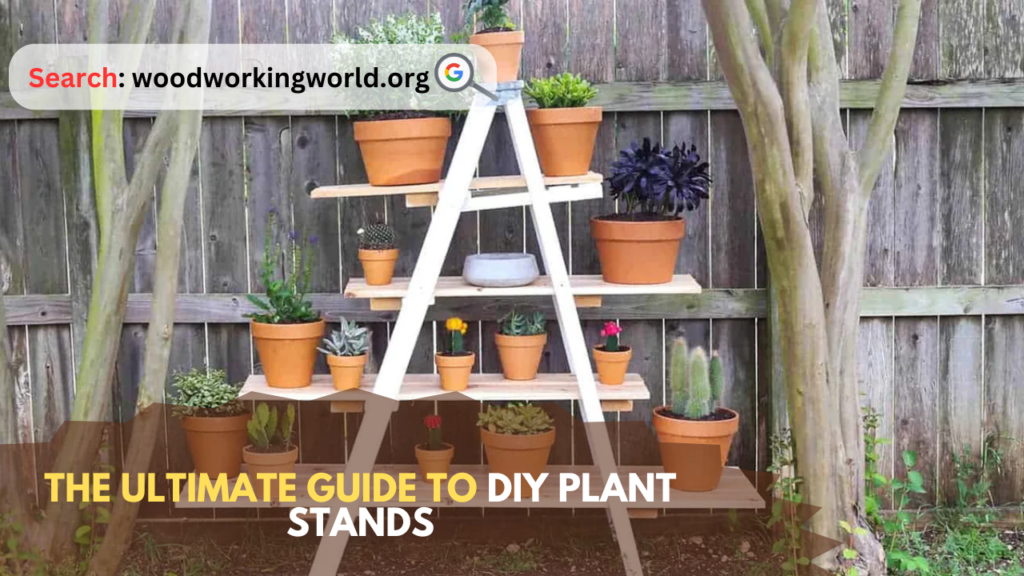The Ultimate Guide to DIY Plant Stands
Introduction to DIY Plant Stands
DIY plant stands are a fun, creative way to showcase your plants while adding a personal touch to your home decor. Whether you’re looking to display a few small houseplants or create a multi-tiered display for an entire garden collection, building your own plant stand is an affordable and rewarding project. With the right materials and tools, you can create a functional and stylish stand that fits perfectly in your home.

Why Make Your Own Plant Stand?
Creating your own plant stand offers several benefits. Not only can you design it to fit your space and aesthetic, but you can also save money compared to buying pre-made options. DIY plant stands allow you to customize the size, color, and material to suit your specific needs. Plus, it’s a fun project that helps improve your crafting skills!
Materials You’ll Need for DIY Plant Stands
Wood
Wood is the most popular material for DIY plant stands due to its versatility and ease of use. Whether you prefer a rustic or modern look, wood can be adapted to any style.
Metal
For an industrial or minimalist design, metal is an excellent choice. You can use pipes, rods, or metal sheets to create a sturdy and sleek plant stand.
Concrete
Concrete stands are perfect for adding a modern touch to your decor. While heavier to work with, concrete offers durability and a clean, contemporary look.
Recycled Materials
Repurposing old crates, pallets, or even furniture pieces is an eco-friendly and budget-friendly way to create a plant stand. With a bit of creativity, these materials can be transformed into unique plant displays.
Start Your Next Project With Teds’ Archive Of 16,000 Plans!
Instant access to all 16,000 woodworking plans with step-by-step details, photos, materials lists and more
Monthly free plans with lifetime membership access – No renewals, recurring fees or other charges

Step-by-Step Guide to Building a DIY Plant Stand
Simple Wooden Plant Stand
- Materials Needed: Wood boards, nails or screws, saw, hammer or screwdriver, wood finish.
- Instructions: Measure the height and width of your plants, then cut your wood pieces to the desired size. Assemble the base and sides, and secure them with nails or screws. Sand and finish the wood for a polished look.
- Optional: Add decorative elements like paint or staining to match your decor.
Multi-Tiered Plant Stand
- Materials Needed: Wood boards or metal rods, screws, measuring tape, saw.
- Instructions: Cut your boards into different sizes for each tier. Attach the tiers vertically, ensuring they’re spaced evenly. You can use metal rods for extra stability and a modern look.
- Optional: Add wheels at the bottom for easy mobility.
Hanging Plant Stand
- Materials Needed: Strong rope or chain, hooks, a wooden plank or shelf.
- Instructions: Attach the hooks to the ceiling or wall, then hang the rope or chain from them. Secure a wooden plank or shelf to hold your plants.
- Optional: Paint or stain the wood to match your home’s theme.
Industrial Style Plant Stand
- Materials Needed: Metal pipes, metal brackets, screws, and a saw.
- Instructions: Cut the metal pipes into the desired lengths and connect them using brackets. Assemble the frame to create a sturdy, industrial-looking plant stand.
- Optional: Add a wooden shelf for a mixed-material design.
Tools You Need for DIY Plant Stands
Basic Tools
- Saw (for cutting wood or metal)
- Hammer or Screwdriver (for assembly)
- Measuring Tape (for accuracy)
- Wood Glue or Nails (to secure pieces)
- Sandpaper (for smoothing rough edges)
Specialized Tools for Advanced Projects
- Power Drill (for faster assembly)
- Pipe Cutter (for metal projects)
- Miter Saw (for angled cuts)
Creative Ideas for Customizing Your DIY Plant Stand
Adding Paint or Stain
Enhance the appearance of your plant stand with a coat of paint or wood stain. Choose colors that complement your existing decor or go bold for a statement piece.
Incorporating Unique Designs
Customize your plant stand with unique features like geometric patterns, carved designs, or custom shapes to make it stand out.
Using Vintage or Recycled Materials
Repurpose old furniture or materials you already have at home. Crates, pallets, and old shelving units can be transformed into stylish and eco-friendly plant stands.
Tips for Designing a Plant Stand That Fits Your Space
Measuring Your Available Space
Before starting your project, measure the area where you want to place the plant stand. Make sure it will fit and leave enough room for plant growth.
Choosing the Right Height
Select a height that complements the size of your plants and fits well in your space. A lower stand is great for shorter plants, while taller stands work well for larger or trailing plants.
Matching Your Home Decor
Choose materials and colors that match your existing furniture and room theme. A wooden stand works well in a rustic setting, while a sleek metal stand fits modern spaces.
Common Mistakes to Avoid When Building a DIY Plant Stand
Inadequate Weight Support
Make sure your plant stand is strong enough to support the weight of your pots. Use sturdy materials and secure joints to prevent wobbling or collapsing.
Incorrect Measurements
Always double-check your measurements before cutting. Incorrect measurements can lead to pieces that don’t fit together properly.
Not Accounting for Weather
If you’re building an outdoor plant stand, ensure the materials are weather-resistant. Wood should be treated, and metal should be coated to prevent rust.
Where to Place Your DIY Plant Stand
Indoor Plant Stands
Place your plant stand near a window with plenty of natural light. Living rooms, kitchens, and entryways are great spots for displaying plants.
Outdoor Plant Stands
Position your outdoor plant stand on your patio, balcony, or in the garden. Make sure it’s in a sheltered spot to protect your plants from extreme weather conditions.
Balcony and Patio Plant Stands
If you have a small outdoor space, tiered or hanging stands are ideal for displaying plants without taking up too much room.
Conclusion
Building your own plant stand is a fun and practical way to personalize your space. Whether you’re making a simple wooden stand or an elaborate industrial display, DIY plant stands allow you to showcase your creativity while providing a functional solution for your plants. With a little effort and the right materials, you can create a beautiful and customized stand that will enhance your home and garden.
FAQs
1. Can I build a plant stand without power tools?
Yes! Many DIY plant stands can be built using basic tools like a saw, hammer, and screwdriver. If you’re using wood or recycled materials, power tools are not necessary.
2. How do I make a sturdy plant stand for heavy pots?
Use strong materials like metal or thick wood, and ensure the base is wide and sturdy. Reinforce joints with screws or brackets for added stability.
3. What are some budget-friendly ideas for DIY plant stands?
Repurposing old crates, pallets, or unused furniture is a cost-effective way to create plant stands. You can also use inexpensive materials like bamboo or plywood for a simple design.
4. How can I make a plant stand that won’t tip over?
Make sure the stand has a wide base and is made from sturdy materials. If you’re building a tall stand, reinforce it with additional supports or bracing.
5. How do I customize a DIY plant stand to match my room decor?
Choose materials and colors that complement your existing furniture and design. Add personal touches such as paint, stain, or decorative elements to make the stand unique to your style.
Please leave a review and follow for more creative plant stand ideas!